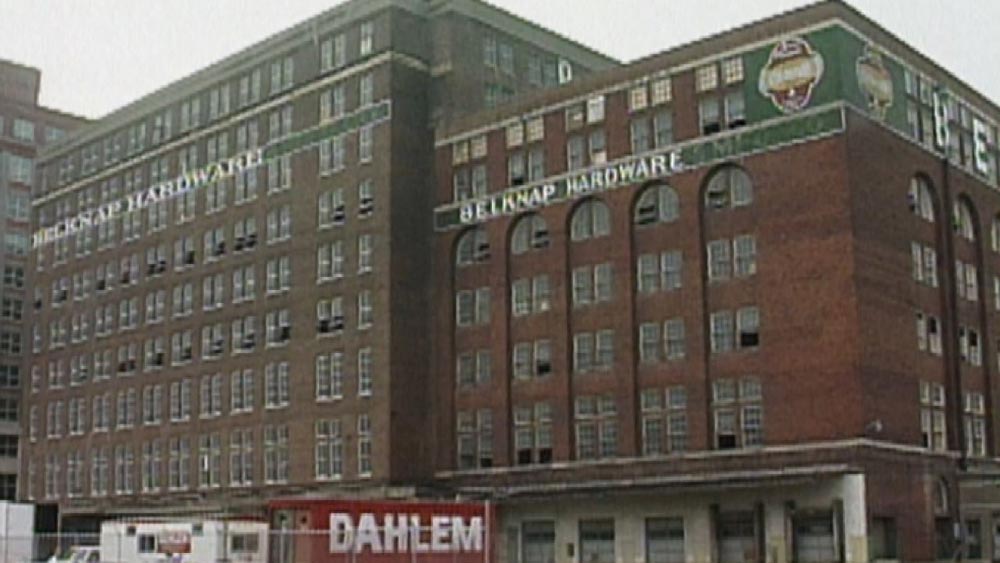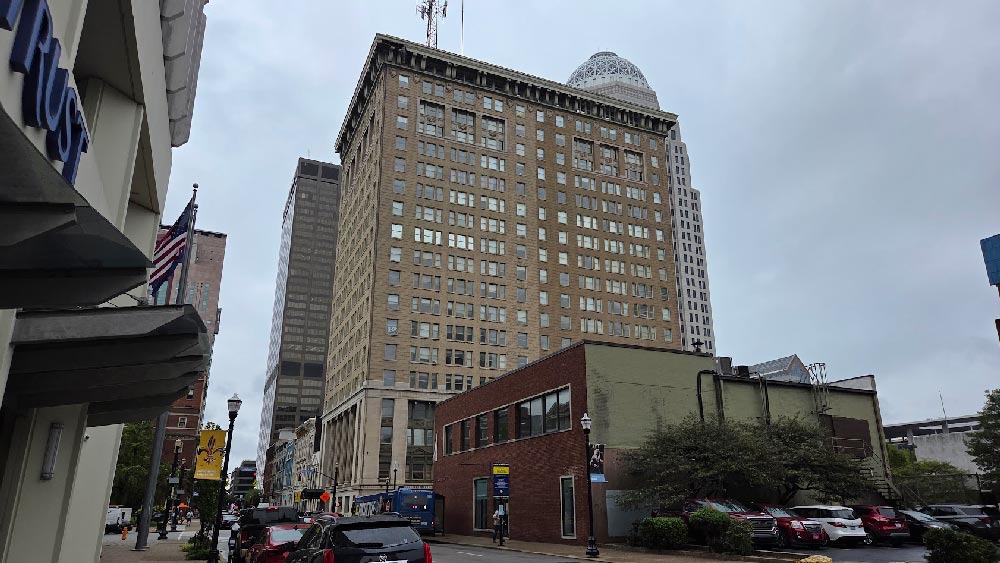Downtown Louisville’s built environment has a complicated history. Prior to the 1930s, the city’s core generally fit the traditional urban pattern of dense, mixed-use structures aligned along a grid. This was not perfect of course, putting heavy industry next to housing leads to widespread pollution exposure, but the city contained many features that would now be considered a sign of good urban fabric.
This traditional urban pattern was disrupted primarily by two forces working hand in hand: the shift to car-centric infrastructure and urban renewal/redevelopment. Much of Louisville’s history was demolished and paved over, starting with the slum clearance programs of the 1930s and leading into the 1970s with urban renewal. Many thousands of structures were lost, and others that still exist have been left vacant or underutilized in recent years. The history behind these lost and vacant structures are often neglected, so lets take a look at some of the stories that lie within them.
Old National Theater

Sitting at 5th and Walnut (now Muhammad Ali), the Old National Theater has a fittingly dramatic history. The huge, ornate theater was built in 1913 and demolished four decades later. At opening, it was one of the largest venues of its kind in the city. The theater was originally operated by the National theater circuit, but on the opening night, the main star of the first performance failed to show. Rumors circulated that this was intentionally caused by one of National’s rival circuits, B.F. Keith. This rivalry had played out across the country, but it wrapped up quickly in Louisville when B.F. Keith bought out the theater in 1914.
Under new ownership, the theater was still not as successful as hoped. B.F. Keith would drop the theater from its retinue a few years later. The venue would then shift between different uses, including motion pictures and burlesque shows. It eventually became one of the city’s black only movie theaters during segregation, being located at the heart of Walnut Street. Eventually, the theater was torn down in 1952 to make way for a parking garage that never came. It sits as a surface lot to this day.
Central Station

Central Station was once one of the city’s pre-eminent rail stations, located at 7th and River Road. Central Station was preceded by Union Depot, which was destroyed by an 1890 tornado and needed a replacement. The station was erected along with Union Station on Broadway briefly after, and utilized for intercity train service for the following decades. The station was famously visited by President Franklin Roosevelt in 1932 and 1938.
The riverfront location was useful in many ways; streetcar lines ran right by the station and the waterfront location allowed easy access to riverboats, but also exposed the station to the floodwaters of the Ohio (as seen above). This required service to often be switched to Union Station instead. Intercity train service in Louisville also had reached its peak in the 1920s, and the station was used less and less relative to Union Station. The last train would depart Central in 1964 (although some sources provide dates as late as 1971). Ideas were thrown around such as converting the structure to a railway museum, but the structure would briefly house the Actor’s Theater before being torn down to make way for I-64. What rail service remained was consolidated at Union Station until 2003, when Louisville lost its rail service.
Belknap Manufacturing Building

The Belknap Manufacturing Building was a very large structure that sat at 1st and East Washington, at what is now Humana’s Belknap Park. The large structure was part of a campus of warehouses and offices operated by Belknap Hardware and Manufacturing Company, most of which was built up during the 1910s and 20s. Other buildings of a similar type were part of this complex and demolished, but we are specifically referring to the one at 1st and Washington here. The only remaining part of this campus is Humana’s Waterside Building.
There is not much recorded history about the building itself, as it was mostly used for storage seemingly. The building’s significance in many minds came from how it was demolished. Belknap Hardware and Manufacturing was defunct by 1985, and much of their former complex north of Main was sold to Humana. Humana sought a green connection to the waterfront via a new park, so planned to implode the building north of the Waterside Building. MTV caught wind of this, and created a TV event around imploding the building. Celebrities such as Sandra Bullock and Sylvester Stallone joined the program to help promote the upcoming movie “Demolition Man”. The structure’s demolition was broadcast live on MTV on October 3, 1993.
Landmark Building

While many historic structures have been lost over the years, some sit vacant, waiting for reactivation. Among them is the Landmark Building, positioned at the intersection of Third and Liberty across from the Omni Hotel. The structure is among the oldest in downtown Louisville, erected in 1858. It was the first federal building in Louisville, serving as a customs house and post office. The building was home to many notable tenants, such as WHAS and the Courier Journal.
The Landmark Building last transferred ownership in 2006, back when it was occupied by office tenants. The entire first floor is now boarded up, with the back entrance seemingly fenced off, so it seems unlikely any tenants remain. There have been plans in the works for nearly a decade now to turn the building into a boutique hotel, but the project recently failed to secure funding from the city. No updated plans have been publicly released on this building.
Kentucky Home Life Building

Possibly the largest vacant structure in downtown Louisville, the Kentucky Home Life Building sits empty right next to city hall at 5th and Jefferson. Originally named the Inter-Southern Insurance Building, the 18-story structure was built in 1912. The Home Life Building was well occupied by tenants until pretty recently, with the COVID pandemic and work from home siphoning off the remaining occupants.
While the bottom floor is currently boarded up, there is some momentum on fixing up the pivotal building. It was bought in 2021 by a Mississippi-based developer who is seeking to renovate and convert it into a mixed-use project, featuring a hotel, apartments, and retail. The project is one of four finalists for receiving funding from the new Downtown Building Conversion fund, and may be a favorite due to its large-scale residential component.
Wrapping it up, for now
This list is by no means comprehensive. Louisville’s legacy of urban renewal and similar programs gives us a long history of losing important structures. Beyond those, there are also several vacant historical structures that lie in wait to be revitalized. This may be a bit of a depressing realization at first, but it lets us know how important historic preservation is. Our built environment is a physical manifestation of our history, so when we treat it with disregard, we can lose ourselves to some extent. This also makes revitalizing what remains so important, and in that realm, there is some positive movement but we can always push further.
